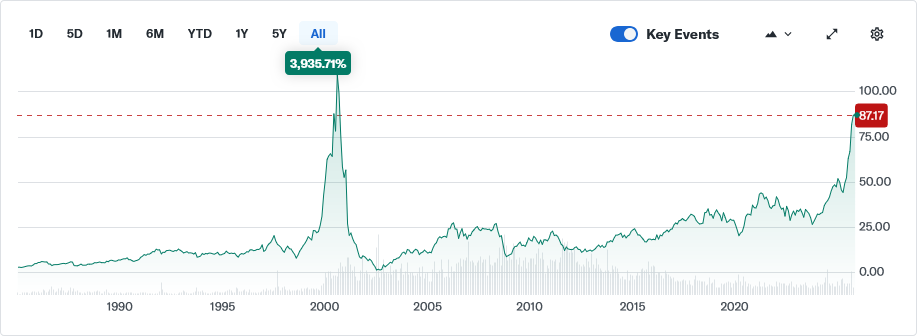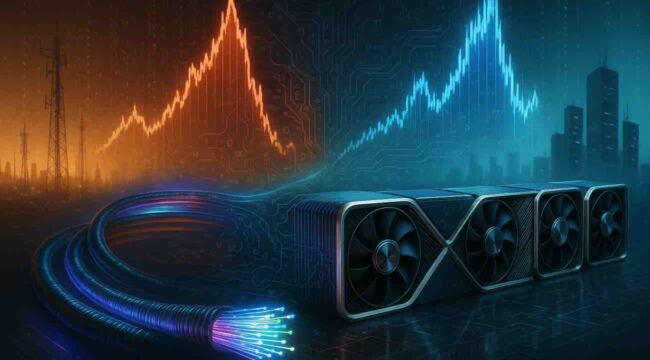Dotcom Deja Vu
During the dotcom boom, fiber optic cabling was a scorching-hot sector.
This is the wiring the internet runs on. The arteries and veins of the data world.
Corning (NYSE: GLW) was the darling of fiber optics in the 1990s and into 2000. This classic American company had been a leader in specialized glass and ceramic materials for more than a century.
Starting in the 1960s, they invested heavily in the idea of a glass-based cable which could transmit voice and data better than copper.
That research turned into the fiber optic revolution, and it paid off as the internet took over in the 1990s.
Corning became a dotcom bubble star. Take a look at the chart below, which shows the price of Corning (NYSE: GLW) from 1980 to today.

(If the chart is too small, head over to Yahoo Finance for a larger version. For the time period, select “All”.)
What a story this chart tells! Corning shares soared from around $9 in 1998 to a peak of $109 in 2000. A handsome 12x gain in about 2 years.
Corning spent billions building new plants to satisfy seemingly infinite demand for internet cabling.
But after the dotcom bubble burst, demand evaporated. It turns out the world had vastly overestimated the amount of fiber that was needed.
A technological breakthrough called DWDM multiplied the capacity of fiber optics by up to 100x. Suddenly all the big telecom companies had spent way too much on their fiber optic networks.
After the bubble popped, only about 3% of the fiber optic that had been laid down was necessary. (Interestingly, Google scooped up much of this “dark fiber” at bargain prices from 2004-2006.)
Corning shares crashed from over $109 in September of 2000 to $1.50 in August of 2002. That’s a painful 98% fall. The stock has still not reached its dotcom highs to this day, although it’s done extremely well lately.
The Inevitable NVIDIA Comparison
Today NVIDIA is the darling of the AI boom. Shares have soared from around $12 in October of 2022 to $181 as I write this 3 years later.
November of 2022 is when OpenAI released ChatGPT-3, which is the AI model that took the world by storm. NVIDIA chips are what AI models like ChatGPT are built with, and mostly run on.
Ever since then, NVIDIA has had a historic run. Since 2022 quarterly revenue has soared from around $7 billion to $46 billion.
Simply remarkable.
My question is: can it last?
The World’s Best Monopoly
Today NVIDIA essentially has a monopoly on the hardware necessary for advanced AI models.
But as we saw with Corning, innovation has a tendency to get in the way of money-printing monopolies. Engineers tend to find a way to get around expensive roadblocks.
With Corning, it was a breakthrough that 100x’d the capacity of fiber optic cables that ruined the party.
For NVIDIA, it could be a breakthrough that makes building and running AI models far cheaper. We’ve already had one major breakthrough when Chinese AI firm DeepSeek released its revolutionary R1 model.
DeepSeek R1 offered a new, far more efficient way to build and run AI models. Aspects of it have since been adopted by all the big players.
The question is, will we see a 10x or 100x efficiency AI breakthrough like we did with fiber optics? It seems inevitable.
Tens of thousands of the world’s smartest engineers are currently working on making models smarter and more efficient. Eventually a major efficiency breakthrough will happen.
And with China officially cut off from advanced NVIDIA chips, they have a powerful incentive to circumvent those proprietary chips. If this hypothetical breakthrough happens, I expect it will be from the East.
Now, I can’t say when it will happen, or if it will even crash demand for NVIDIA chips. Maybe demand for cutting-edge GPUs will continue growing as AI takes over the planet.
But maybe we’re in a bubble, caught up in the euphoria.
Unfortunately, I misplaced my crystal ball. All I’m saying is that the parallels to the dotcom boom and bust are stunning. And that innovation tends to find a way.
Corning fell 98% from its 2000 peak in a span of about 2 years. And it was still, fundamentally, a great company with amazing research and production facilities. But it was rough sledding for a while after the crash.
To be clear, I am NOT saying to short NVIDIA. That’s a risky proposition. Eventually the time for puts may come, but I’m personally steering clear for now. I’ve already tried a few tiny puts on NVIDIA twice and failed. Timing the downfall of a tech darling is an incredibly tough job.
And as we know, bull markets always go on longer than seems rational or reasonable. And that, ladies and gents, is a nice note to end on.



Comments: